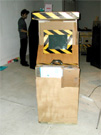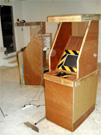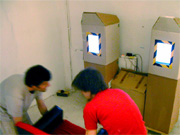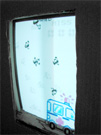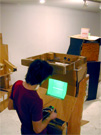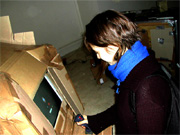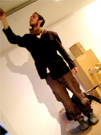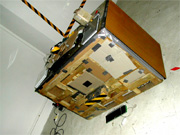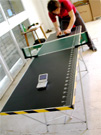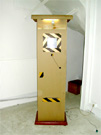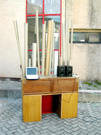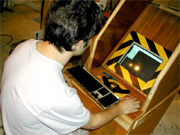- Workshop: ENIAROF Video Arcade
- Organisation: Antonin Fourneau + Douglas Edric Stanley
- Participants: Antonin Fourneau, Pierre-Erick Lefebvre, Manuel Braun, Loïs Roussillon, Aurélien Boyer, Stéfan Piat, Douglas Edric Stanley
- Location: L’école supérieur d’art d’Aix-en-Provence
- Date: 1-4, 7-11, 14-19 March 2005
- Website: ENIAROF website
We have been frantically building the Video Arcade for ENIAROF, which opens tomorrow (more later).
ENIAROF is a projet initiated by 5th-year student Antonin Fourneau, one of the more active participants of the Atelier Hypermedia. Although I was originally asked by my director to head the project, I secretly declined as I believe that students should be able to take on ambitious projects on their own, and find the political and economic means to autonomously bring them to fruition. So Antonin and I struck a deal: I would head the construction of the Video Arcade, and he would overlook the project as a whole. This would allow me to organize a workshop that would give institutional legitimacy to the project, while leaving the rest open-ended for the various parallel propositions that were bound to show up on their own. The deal has allowed me to concentrate with the students on question of video game aesthétics, a field we’ve been exploring since back in 1999 with Bernd Diemer and Esc. to Begin. This also allows me to not worry myself with the larger issues of ENIAROF that ultimately belong to Antonin’s initiative.
ENIAROF grew out Antonin’s mixed feelings about Villette Numérique 2004 where he collaborated as part of the FAN (Folies Area Network) project of Téléférique. We were discussing at the time whether it was possible to find other means of showing experimental digital creations, notably of the ilk we have been exploring in the Atelier Hypermedia for the past two years: video game “languages”, game console hacking, mobile experiments, critical embedded circuitry, “playable instruments”, and lo-fi & D.I.Y. computer culture. Contemporary art galleries have been almost impossible to penetrate with these experiments, and we’ve been getting tired of invitations uniquely to the media-hyped ghettos of digital arts festivals. Despite all these festivals, and despite all the media reports, there has been little critical, market and institutional acceptation of the emerging digital cultures. We are tolerated, that is all. Hence an untenable future, and a need for alternatives.
As Antonin has been interested the past few years with emerging network trends — blogs, Flash Mobs, the open-source movement — he decided to put these logics at work in a Fête Foraine (Carnaval) housed within an art school. He made an open call for proposals, created a non-profit, and started bringing in institutional (City of Aix-en-Provence, the Tourist board, The Art School, etc.) and commerical partners (Compagnie Emaüs, Quincaillerie Aixoise, etc).
This project as a whole was of great interrest for the Atelier Hypermedia, but ultimately there was one specific question we wanted to explore. If you’re building experimental video games, how should they be shown? How can you stradle the fence between gallery and carnaval, exhibit and play? Hence the ENIAROF Video Arcade was born. I don’t think we’ve relaly succeeded in answering the question, but at least the experiment has been interesting.
Many of the proposals are simply re-contextualisations of old-skool video games. Manuel built a large-scale FIRE! requiring two people to carry about a large sofa to bounce survivors into the ambulance, and I’ve ressurected my September 2001 Space Invaders emulator I built after the World Trade Crash and readapted it as a one-armed immersive game. Pierre-Erick, Antonin, Loïs and Stéfan have adapted several of their programs into traditional (well not really) video game cabinets. Many of the games require jumping around, screaming (Antonin’s “Pince Vocale”), or frantically beating a giant button in front of a tiny little screen while surrounded with booming distorted-guitar amplifiers (Pierre-Erick). Indeed it’s a pretty Rock n’ Roll atmosphere.
All the building materials were donated by the Quincaillerie Aixoise (a hardware store) and the French robin-hood recycling network Emaüs. As Emaüs is spread across all of France, Antonin’s idea was that they could be tapped-into to build ENIAROFs all across France, allowing for proposals emanating from any number of various local groups.
Antonin and I have been taking pictures of the construction process. I’ve included a few to give an idea of the working method. Ok, so the photos aren’t so great. But hey, we were busy!



